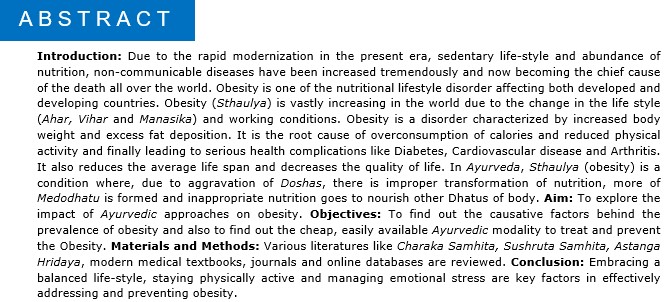Exploring the Impact of Ayurvedic approaches on Obesity: A Scientific Research Perspective
DOI:
https://doi.org/10.21760/jaims.8.8.32Keywords:
Non-communicable disease, Sthaulya, Ayurveda, Obesity, Pathya-Apathya, Santarpana, Ashta Nindit PurushaAbstract
Introduction: Due to the rapid modernization in the present era, sedentary life-style and abundance of nutrition, non-communicable diseases have been increased tremendously and now becoming the chief cause of the death all over the world. Obesity is one of the nutritional lifestyle disorder affecting both developed and developing countries. Obesity (Sthaulya) is vastly increasing in the world due to the change in the life style (Ahar, Vihar and Manasika) and working conditions. Obesity is a disorder characterized by increased body weight and excess fat deposition. It is the root cause of overconsumption of calories and reduced physical activity and finally leading to serious health complications like Diabetes, Cardiovascular disease and Arthritis. It also reduces the average life span and decreases the quality of life. In Ayurveda, Sthaulya (obesity) is a condition where, due to aggravation of Doshas, there is improper transformation of nutrition, more of Medodhatu is formed and inappropriate nutrition goes to nourish other Dhatus of body. Aim: To explore the impact of Ayurvedic approaches on obesity. Objectives: To find out the causative factors behind the prevalence of obesity and also to find out the cheap, easily available Ayurvedic modality to treat and prevent the Obesity. Materials and Methods: Various literatures like Charaka Samhita, Sushruta Samhita, Astanga Hridaya, modern medical textbooks, journals and online databases are reviewed. Conclusion: Embracing a balanced life-style, staying physically active and managing emotional stress are key factors in effectively addressing and preventing obesity.
Downloads
References
Sushruta. Sushruta Samhita (Sushrutavimarshini Hindi Commentary), Vol. 3. Anantram Sharma, editor. 1st ed. Varanasi: Chaukhamba Surbharti Publication; 2004. Sutrasthan, 15/32-33.p 410.
Pandey A. K and Singh R. H.: “A Study of the Immune status in patients of diabetes mellitus and their Management with certain Naimittika Rasayana drugs”, JRAS. Vol. XXIV. No. 3-4, 2003; 48-61
Pandey A.K and Singh R.H. (2012): A Clinical Study on Certain Diabetic Complications under the Influence of Naimittika Rasayana Therapy w.s.r. to Nishamalaki and Shilajatu), PhD. Thesis, Department of Kayachikitsa, IMS, BHU, Varanasi.
Jaspreet Singh & A. K. Pandey: Clinical Evaluation of Pushkaramula (Inula racemosa) Capsule in the patients of Metabolic syndrome”, International Journal of Medicine and Pharmaceutical Sciences (IJMPS), ISSN(P): 2250-0049; ISSN(E): 2321-0095, Vol. 4, Issue 2, Apr 2014, 9-20.
Lau D.C. et asl (April 2007). "2006 Canadian clinical practice guidelines on the management and prevention of obesity in adults and children [summary]", CMAJ, 176 (8): S1–13.
World Health Organization (WHO) (2000). Obesity: Preventing and Managing the Global Epidemic. Report on a WHO Consultation. Geneva. (WHO technical report series 894).
P.J.English, M.A.Ghatei, I.A.Malik, S. R. Bloom and J. P. H. Wilding ( June-1, 2002): Food fails to suppress ghrelin levels in obese humans, The Journal of Clinical Endocrinology & Metabolism, 87(6):2984–2987.
Charaka Samhita, Sanskrit text with English translation by Dr. Shashirekha H.K. and Dr. Bargale Sushant Sukumar, Chaukhambha Publications, New Delhi, Sutrasthana, Chapter 21, verse 4
Sitaram B. Bhavaprakash of Bhava Mishra, Madhyam and Uttara Khanda, Volume II, Chapter 39, Page 437, Chaukhamba Orientalia, 2010
Charaka Samhita, Sanskrit text with English translation by Dr. Shashirekha H.K. and Dr. Bargale Sushant Sukumar, Chaukhambha Publications, New Delhi, Sutrasthana, Chapter 21, verse 4
https://www.verywellhealth.com/how-obesity-is-diagnosed-4690037
https://www.upmc.com/locations/hospitals/hamot/services/bariatric/defining-obesity
Charaka Samhita, Sanskrit text with English translation by Dr. Shashirekha H.K. and Dr. Bargale Sushant Sukumar, Chaukhambha Publications, New Delhi, Sutrasthana, Chapter 21, verse 18,19
https://theancientayurveda.com/a-review-study-on-obesity-through-ayurveda-perspective/
Sushruta. Sutra Sthana, Cha.15 Doshadatumalkshayavriddivinjaniya Adhyaya verse 32. In: Jadavaji Trikamji Aacharya, Editors. Sushruta Samhita. 8th ed. Varanasi: Chaukhambha Orientalia;2005.
Mishra, L.C. (2003). Scientific Basis of Ayurvedic therapy, Chapter 9 Obesity (Medoroga) in Ayurveda; eBook, published by CRC press, Taylor & Francis Group.
Shastri, P.K (1983), (translater), Caraka samhita, Part I, 2nd ed., Chaukhambha Sanskrit Sansthan, Varanasi, India, p. 595.
Bleich S, Cutler D, Murray C, Adams A (2008). "Why is the developed world obese?". Annu Rev Public Health29: 273–95. doi:10.1146/annurev.publhealth.29.020907.090954. PMID 18173389.
Drewnowski A, Specter SE (January 2004). "Poverty and obesity: the role of energy density and energy costs". Am. J. Clin. Nutr.79 (1): 6–16.
Hamann A, Matthaei S (1996). "Regulation of energy balance by leptin". Exp. Clin. Endocrinol. Diabetes104 (4): 293–300. doi:10.1055/s-0029-1211457. PMID 8886745.
Hamann A, Matthaei S (1996). "Regulation of energy balance by leptin". Exp. Clin. Endocrinol. Diabetes104 (4): 293–300. doi:10.1055/s-0029-1211457. PMID 8886745.
Rao CR, Sen PK, Flier JS (2012). Handbook of Statistics: Bioinformatics in Human Health and Heredity; Published by North Holland; 1 edition, Kindle Edition, 1 edition.
Raina GS (2011). Obesity being the major health burden needed to be chased: A systemic review. J Appl Pharm Sci. 2011;1:238–45.
Mishra, L.C. (2003). Scientific Basis of Ayurvedic therapy, Chapter 9 Obesity (Medoroga) in Ayurveda; eBook, published by CRC press, Taylor & Francis Group.
Boulpaep, Emile L.; Boron, Walter F. (2003). Medical physiology: A cellular and molecular approach. Philadelphia: Saunders. p. 1227. ISBN 0-7216-3256-4
Kuniko Takagi, Romain Legrand, Akihiro Asakawa, Haruka Amitani, Marie François, Naouel Tennoune, Moïse Coëffier, Sophie Claeyssens, Jean-Claude do Rego, Pierre Déchelotte, Akio Inui, Sergueï O. Fetissov. Anti-ghrelin immunoglobulins modulate ghrelin stability and its orexigenic effect in obese mice and humans. Nature Communications, 2013; 4 DOI: 10.1038/ncomms3685, site on 08/02/2014.
Grundy SM (2004). "Obesity, metabolic syndrome, and cardiovascular disease". J. Clin. Endocrinol. Metab.89 (6): 2595–600. doi:10.1210/jc.2004-0372. PMID 15181029.
Grundy SM (2004). "Obesity, metabolic syndrome, and cardiovascular disease". J. Clin. Endocrinol. Metab.89 (6): 2595–600. doi:10.1210/jc.2004-0372. PMID 15181029.
Grunstein, R.R. and Widcox, I. (1994). Sleep-disordered breathing and obesity, Clin.Endocrinol. Metab. Baillier’s, 8, 601.
Daugero, K.D. (2001). A new perspective on glucorticoid feedback: relation to stress, carbohydrate feeding and feeding behavior, J. Neuroendocrinol., 13, 1088.
Larsson, B. et al (1984), Abdominal adipose distribution, obesity and risk of cardiovascular disease and death: 13 year follow up of participants in the study of men born in 1913, Br. Med. J., 288, 1401.
Esposito K. et al (2004). "Effect of lifestyle changes on erectile dysfunction in obese men: A randomized controlled trial". JAMA, 291 (24): 2978–84.
Sastri A.D. Susruta Samhita, Chikitsa sthana, 24th Chapter, Page 135, Chaukhamba Sanskrit Sansthan, 2021















